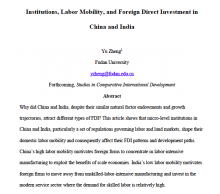Institutions, Labor Mobility, and Foreign Direct Investment in China and India

Why did China and India, despite their similar natural factor endowments and growth trajectories, attract different types of FDI? This article shows that microlevel institutions in China and India, particularly a set of regulations governing labor and land markets, shape their domestic labor mobility and consequently affect their FDI patterns and development paths. China’s high labor mobility motivates foreign firms to concentrate in labor-intensive manufacturing and exploit the benefits of scale economies. India’s low labor mobility motivates foreign firms to move away from unskilled-labor-intensive manufacturing and invest in the modern service sector where the demand for skilled labor is relatively high.
The publication version of this paper is viewable at http://link.springer.com/article/10.1007%2Fs12116-015-9201-7 and is published in Studies in Comparative International Development, Vol. 51, No. 2 (June 2016), pp. 147-168. The page proofs are graciously posted with the permission of Dr. Zheng Yu. Copyright remains with the authors and Studies in Comparative International Development as originally assigned.
**Posting of this report does not represent an endorsement by the Mr. & Mrs. S.H. Wong Center for the Study of Multinational Corporations and has been done to facilitate research and promote debate about multinational corporations/FDI in and from East Asia.




